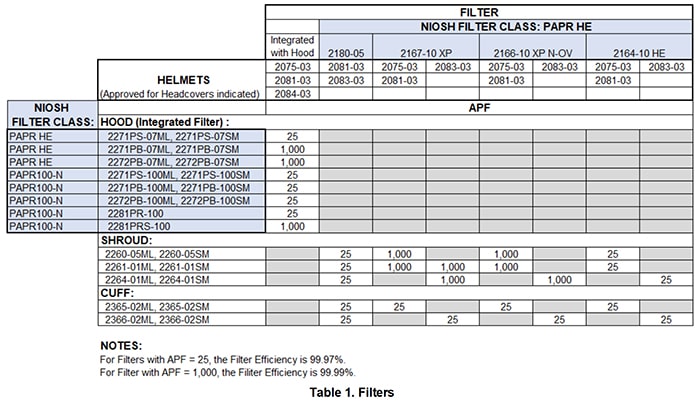Always be aware that MAXAIR Filters are for airborne particulates only; MAXAIR Filters are not for use where gases and vapors need to be filtered.
MAXAIR Cuff and Shroud Systems use individual Filter Caps and Filter Cartridges; Hood Systems use a filter that is integrated into the top of the Hood.
MAXAIR CAPR System Filters are classified by NIOSH as either PAPR HE or PAPR100-N. Table 1. below demonstrates the different filters, their NIOSH Classification, their APF, and their related filter efficiency minimums

Cuff and Shroud Systems – Filter Cartridges:
Page 8 of 13 The 2180-05 HE Filter Cap is MAXAIRs most recent filter innovation design for MAXAIR Cuff and Shroud Systems. This filter provides OSHA 1 APF of 25 and NIOSH HE level particulate filtering efficiency and Silica dust loading capacity at a very low cost. The 2167-10 XP and 2166-10 XP N-OV filter cartridges are convenient snap-on/snap-off filters for use with the MAXAIR CAPR Cuff and Shroud System configurations.
Both Filter Cartridges are also Class PAPR HE and pass NIOSH Silica Dust loading testing
Hood Systems Filters:
PAPR Classes, HE and PAPR100, are primarily determined by filter capabilities, as indicated in the table below.
In general, MAXAIR System filters are not intended to be exposed to water.
If water spray is a potential, it is recommended to use –
If filters do become wet with non-toxic and otherwise non-harmful material, they should be allowed to dry thoroughly before next use.
Note that all head and face covers are designed for single use. Hoods (with integrated filters) are single use headcovers.
It depends upon the application, the environment where used, the frequency and duration of use, and the organization’s protocol for the prevention of cross contamination.
Regardless, MAXAIR CAPR’s Yellow LED provides a self-monitoring function that effectively takes these concerns into consideration. The yellow LED will illuminate when airflow intake begins to be compromised near the threshold of 6 cfm (170 lpm). This visual warning provides the user ample time to exit the working environment, and change out a heavily loaded filter.
Otherwise, filter change-out a minimum of every six-to-twelve months is recommended.
There are no procedures for cleaning MAXAIR Filters for reuse. Once the filter is loaded to the point that the Helmet Yellow LED is lighted, or after 6-12 months use, whichever occurs first, the MAXAIR Filter should be discarded per institutional and local regulatory agency recommendations.
Most users prefer to use the Cuff system configuration for Infection Control in patient care areas because it more conveniently accommodates stethoscope use.
The Cuff configurations are the primary choice where contact and fluid contamination are not of major concern as the neck and side and back of head are exposed with a Cuff configuration.
Shroud configurations are usually recommended over cuffs when –
Hood configurations are typically the configuration of choice for when the combination of maximum protection of a Shroud is needed or desired, and when the easy discarding of the entire head cover and filter is acceptable and economic.
Both Shroud and Hood configurations are available in both single and double shroud styles –
MAXAIR Cuff and Shroud configurations use a separate, independently assembled Filter Cap or Filter Cartridge, either the 2180-05 Filter Cap, the 2167-10 XP Filter Cartridge, or the 2166-10 XP N-OV Filter Cartridge. All MAXAIR Hoods have their Filter integrated into the top of the hood.
MAXAIR XP filter designations indicate they meet the NIOSH HE approval for PAPR filtration that requires passing the Silica Dust loading test.
The N-OV designation of the 2166-10 XP N-OV Filter Cartridge indicates that it additionally provides relief from nuisance levels of organic vapors when used with CAPR Shrouds, i.e. levels below the OSHA PEL level, typically 5%-10% of the OSHA PEL.
Some additional considerations for when to choose different configurations include:
The Cuff configurations are the primary choice where full 360 o head contact and fluid contamination is not of major concern as the neck and side and back of the head are exposed with a Cuff configuration.
Shroud configurations are usually recommended over cuffs when –
Hood configurations are typically the configuration of choice when the combination of maximum protection of a Shroud is needed or desired, and the easy discarding of the entire head cover and filter is acceptable and economic.
Both Shroud and Hood configurations are available in both single or double shroud styles.
If you still have a question. Please use the form below to ask us for an answer.
"*" indicates required fields